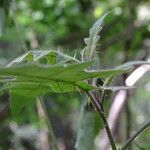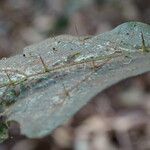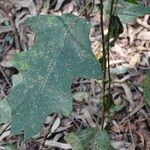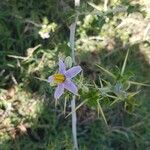Leaves solitary, the upper ones often appearing geminate or ternate; petiole (0.3)1–3 cm long; lamina membranous, 3–20 × 1.5–13.5 cm, ovate to elliptic or oblong-lanceolate, sometimes obovate or ± circular, base sub-hastate or truncate, rounded to cuneate, and ± unequal-sided, apex acute to obtuse or acuminate, irregularly sinuate-lobed to divided, the lobes ± triangular to elongate, entire to sinuate-lobulate, rounded, obtuse or sub-acuminate, the sinuses rounded between the lobes, upper surface ± hairy to glabrous, lower surface very densely greyish-white tomentose, generally with ± straight prickles on the midrib at least beneath.
Cymes lateral, usually leaf-remote or occasionally leaf-opposed, at first sometimes appearing terminal, unbranched or occasionally forked, sub-umbelliform or racemiform, tomentose, usually sparingly armed, the prickles ± straight, 2–13-flowered, usually the lowest flower(s) larger and more prickly, sometimes all flowers unarmed, occasionally flowers solitary; peduncle none or very short; pedicels (5)8–15(23) mm long, slender but stouter in fertile flower(s), erect to recurved, leaving raised scars after abscission, in fruit elongated to 5 cm, strongly thickened distally and stout, ± recurved or deflexed.
Shrub or small tree, 1.2–4.5 m (elsewhere said to reach 8 m), conspicuously armed [or elsewhere unarmed in var. albifolium (C.H. Wright) Bitter]; hairs stellate, forming a white or cineraceous powdery-looking tomentum on all parts except upper side of the leaves, sessile or subsessile, echinoid, regular, soft, short or minute; prickles brown becoming reddish-brown upwards, to 20 mm long and 15 mm wide at the base, stout and recurved to rarely acicular, very sharp, stellate-felty at base and subglabrous upwards to quite glabrous.
Calyx (4)5-lobed or divided, greyish-white tomentose, ± prickly or unarmed, in fruit somewhat enlarged, very often more deeply divided, somewhat glabrescent, sparsely prickly; tube 2–4 mm long, ± campanulate; lobes 2–8 × 1.5–4 mm, triangular to ovate-elliptic or oblong, acute to long-acuminate, hairy mainly on the midrib to glabrous inside, in fruit rather leathery, to 10 × 5 mm, broadly lanceolate.
A shrub or small tree. It grows to 4 m high. The stem is erect and prickly. The bark is greyish-brown. The leaves are green and with lobes. The leaves are deep green above and white and woolly underneath. The leaves are 4.5-14 cm long by 3-11 cm wide. The flowers are white and star shaped. The fruit are orange to brownish berries. They are 5 cm long.
Corolla violaceous to purple or pale mauve, yellowish or whitish, sometimes with purplish-brown markings, 1.3–3 cm across, ± rotate to stelliform; lobes 4–17 × 1.5–3.5 mm, narrowly ligulate, acute, involute at the margins, tomentose outside and hairy mainly on midrib to subglabrous inside.
Ovary 1.5–3(5.5) × 1–3(5) mm, ± globose or ovoid, ± densely hairy, 2-locular; style 6–8(10) mm long, very much shorter in male flowers, straight, very shortly hairy in the lower half or tomentose to near the apex in male flowers.
Small tree or shrub, 1-6 m high. Stems and leaves spiny. Spines 5 mm across base, curved. Leaves deeply sinuately lobed, discolorous. Inflorescence lateral. Fruit yellow. Flowers white or pale violet.
Fruit glossy, greenish becoming yellowish when ripe, later reddish, purplish or brown to blackish, 3.5–5 × 3–5 cm, ± globose to ellipsoid, smooth or warty, ± hairy on upper part, poisonous.
Seeds dirty-yellowish or brownish, 3–5(6) × 2.5–3.5(6) mm, strongly flattened, oblique-reniform or orbicular to ovate or obovate in outline, minutely reticulate all over.
Stamens (4)5–6(10); filaments 0.5–1 mm long; anthers 4–8 mm long, lanceolate-ellipsoid, obtuse basally.
Branches tomentose, gradually glabrescent, the recurved prickles usually conspicuous.
With mostly very big sharp hook-like spines, but sometimes also unarmed.
White tomentum on all parts, except the surface of the leaves
A tree or shrub up to 20 ft. high





